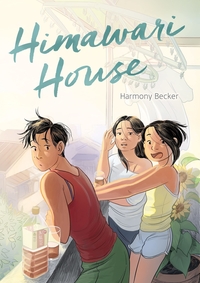Take a photo of a barcode or cover
It's somehow relaxing to read about a group of foreigners finding themselves while being lost in the language and culture of Japan.
A beautifully drawn story of a young woman spending a year in Japan to reconnect with her birth country and all the things about herself she hid while growing up in the US. She stays at a share house with some others, and becomes good friends with two of the other girls, one from Korea, the other from Singapore, who are in Japan for their own reasons, but all three young women are trying to find out who they are and what’s important to them.
I loved the friendship, the artwork, all the food, and the tone of this whole story.
I loved the friendship, the artwork, all the food, and the tone of this whole story.
emotional
funny
reflective
sad
medium-paced
Plot or Character Driven:
Character
Loveable characters:
Yes
Diverse cast of characters:
Yes
M'ha encantat aquest relat sobre 3 noies asiàtiques que conviuen en una casa compartida al Japó i que busquen el seu lloc al món. Un slice of life que reflexiona sobre el concepte de la identitat, de sentir-se fora de lloc per haver emigrat, de les enormes expectatives que dipositen en els fills la majoria de famílies asiàtiques, de la llibertat... Molt interessant, amb unes il·lustracions ben expressives i tendres, però un final massa obert a interpretacions :(
Solid 4.5 stars.
This book brought up some of the feelings I had when I first visited Laos and felt conspicuous even though I technically looked like everyone there. What's particularly poignant is what Nao says about being too Japanese in America and being too American in Japan. I had those feelings a lot growing up about wanting to assimilate but always being different and the things that should've been cherished about my culture being made fun of or thought as strange by others around me who didn't understand. I loved the journeys of the 3 main girls especially and their own reasons for coming to Japan. Himawari House is a concept that I've seen a few times depicted in television where a ragtag bunch of people come together in a common place and through it all start to become a family.
This book brought up some of the feelings I had when I first visited Laos and felt conspicuous even though I technically looked like everyone there. What's particularly poignant is what Nao says about being too Japanese in America and being too American in Japan. I had those feelings a lot growing up about wanting to assimilate but always being different and the things that should've been cherished about my culture being made fun of or thought as strange by others around me who didn't understand. I loved the journeys of the 3 main girls especially and their own reasons for coming to Japan. Himawari House is a concept that I've seen a few times depicted in television where a ragtag bunch of people come together in a common place and through it all start to become a family.
This is so deserving of all the good reviews it's getting! It's just wonderful on every front: coming of age, friendship, crossing cultures, mixed identities, language learning, food, so much crying (but in a pure, feel-it-all way), spectacular art and visual storytelling, bilingual (!) dialogue bubbles...I could go on. I find myself still thinking about Hyejung's story. She and Tina both speak in accented English (represented phonetically), and I admit that this initially made me very uncomfortable, feeling like they were somehow being made fun of, even though this is an own voices book. I was glad that the author included a note at the end, "On the use of accents in this book," which acknowledges the history of accents used for comic or othering effect, and how her aim is to contribute to a different legacy -- one of authenticity and pride in speaking more than one language.
I also learned about a piece of furniture I definitely want to experience someday, the kotatsu: https://en.wikipedia.org/wiki/Kotatsu
The Kirkus review is an excellent summary:
"A shared house in Tokyo brings five young people together. After moving to the U.S. as a child with her Japanese mother and White American father, Nao has returned to Japan for a gap year before college to explore the language and cultural heritage that she deliberately shed-at great emotional cost-in an effort to assimilate. She moves into Himawari House, which she shares with Korean Hyejung and Chinese Singaporean Tina, girls who are attending the same Japanese language institute as Nao. Also resident are two Japanese brothers, outgoing, friendly Shinichi and taciturn, broodingly handsome Masaki. Blending English, Japanese, Korean, and Singlish, the group bonds over meals, excursions, K-dramas, and never-ending conversations about life, love, and family. Becker perfectly captures the heady roller coaster of feelings that accompanies cross-cultural immersion, with ordinary activities serving as barometers of successful adaptation in a new country. The personal stakes of each encounter with Japanese life are even higher for Nao, throwing into relief her internal struggles over her identity. Nao is the focal point, but Hyejung and Tina are well developed, with complex, heartstring-tugging backstories. Most of the text is bilingual, but the occasional use of Japanese or Korean alone effectively mirrors the dislocation of language learners. The predominantly photorealistic art is enhanced with a range of stylized techniques that masterfully communicate emotion. Altogether, this work exemplifies what the graphic novel format can achieve. An unforgettable story of personal growth in an exquisitely rendered setting."
Favorite quotes:
"Instead, we just stuffed our faces. Which is just as good, if not better, than fireworks with a cute boy."
"I wish you would let me worry about you."
The entire exchange on p. 318! Must read the visuals as well as the dialogue. A perfect encapsulation of a particular friend moment.
"My mother, who could weave complex tapestries, rich with nuance and humor, in Japanese...reduced to stringing simple words together like flimsy plastic beads on a necklace. How could she stand it when there was always so much to say?"
"It's Singlish. It's like a mix of all the languages we speak in Singapore, with English as the base."
I also learned about a piece of furniture I definitely want to experience someday, the kotatsu: https://en.wikipedia.org/wiki/Kotatsu
The Kirkus review is an excellent summary:
"A shared house in Tokyo brings five young people together. After moving to the U.S. as a child with her Japanese mother and White American father, Nao has returned to Japan for a gap year before college to explore the language and cultural heritage that she deliberately shed-at great emotional cost-in an effort to assimilate. She moves into Himawari House, which she shares with Korean Hyejung and Chinese Singaporean Tina, girls who are attending the same Japanese language institute as Nao. Also resident are two Japanese brothers, outgoing, friendly Shinichi and taciturn, broodingly handsome Masaki. Blending English, Japanese, Korean, and Singlish, the group bonds over meals, excursions, K-dramas, and never-ending conversations about life, love, and family. Becker perfectly captures the heady roller coaster of feelings that accompanies cross-cultural immersion, with ordinary activities serving as barometers of successful adaptation in a new country. The personal stakes of each encounter with Japanese life are even higher for Nao, throwing into relief her internal struggles over her identity. Nao is the focal point, but Hyejung and Tina are well developed, with complex, heartstring-tugging backstories. Most of the text is bilingual, but the occasional use of Japanese or Korean alone effectively mirrors the dislocation of language learners. The predominantly photorealistic art is enhanced with a range of stylized techniques that masterfully communicate emotion. Altogether, this work exemplifies what the graphic novel format can achieve. An unforgettable story of personal growth in an exquisitely rendered setting."
Favorite quotes:
"Instead, we just stuffed our faces. Which is just as good, if not better, than fireworks with a cute boy."
"I wish you would let me worry about you."
The entire exchange on p. 318! Must read the visuals as well as the dialogue. A perfect encapsulation of a particular friend moment.
"My mother, who could weave complex tapestries, rich with nuance and humor, in Japanese...reduced to stringing simple words together like flimsy plastic beads on a necklace. How could she stand it when there was always so much to say?"
"It's Singlish. It's like a mix of all the languages we speak in Singapore, with English as the base."
This graphic novel was phenomenal. It didn't just have adorable illustrations, an incredibly emotive narrative, and the most lovable characters, but it also had one of the most unique dialogue writing I have ever seen which really effectively captured the feel of language learning.






